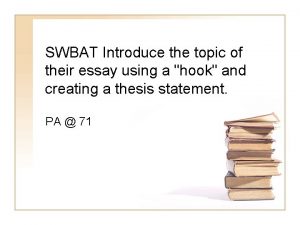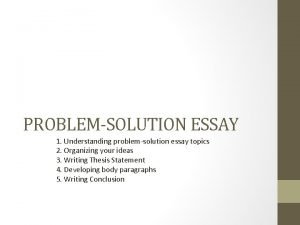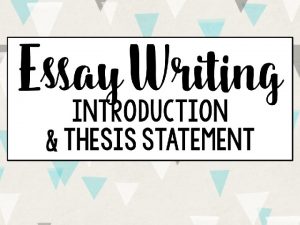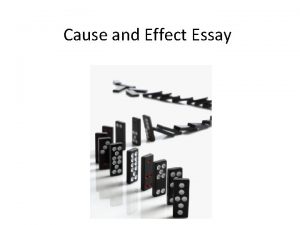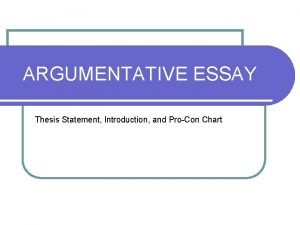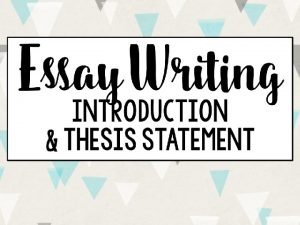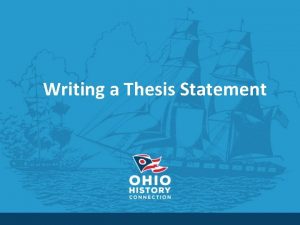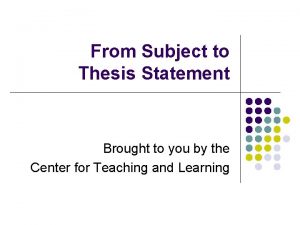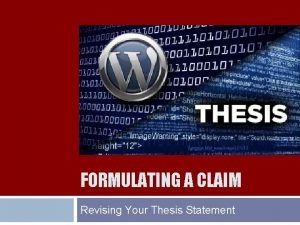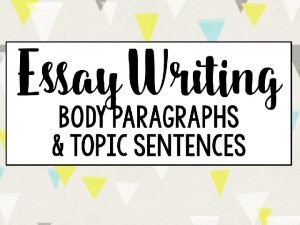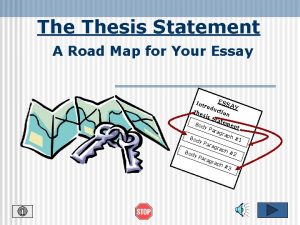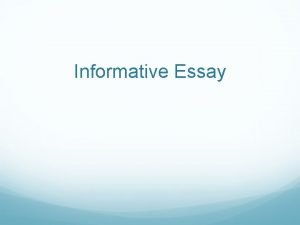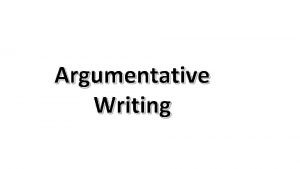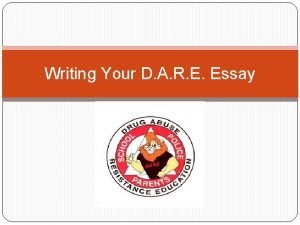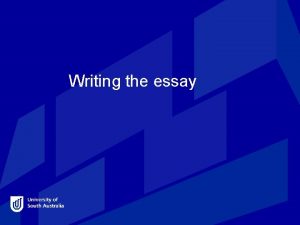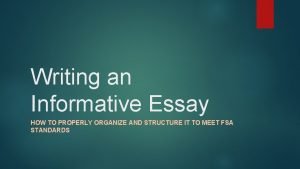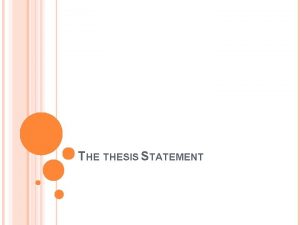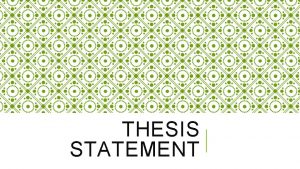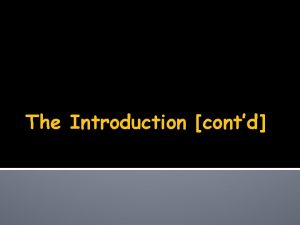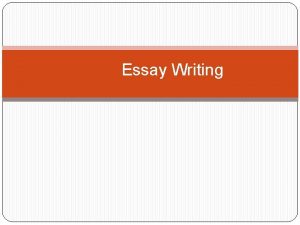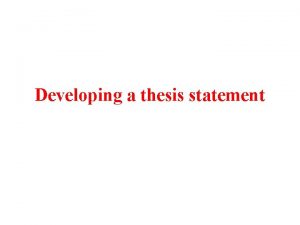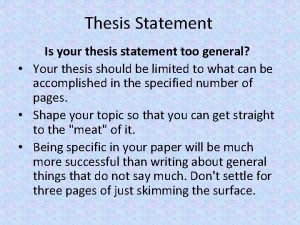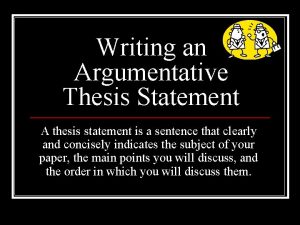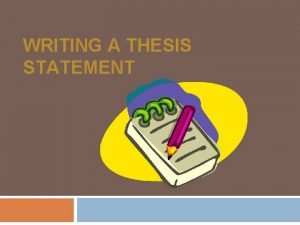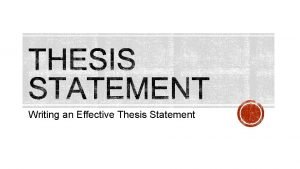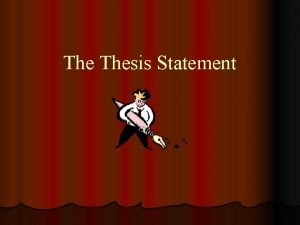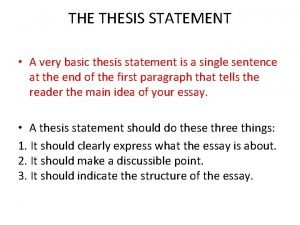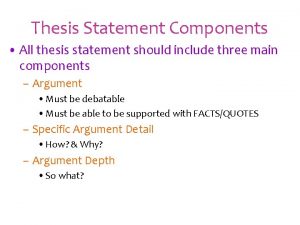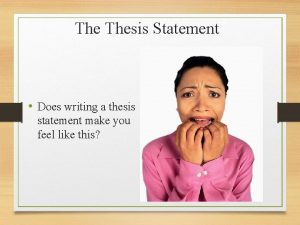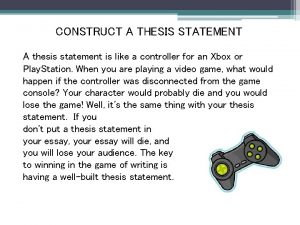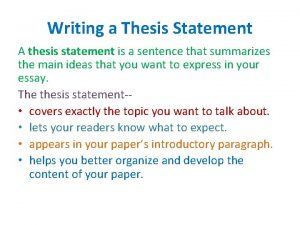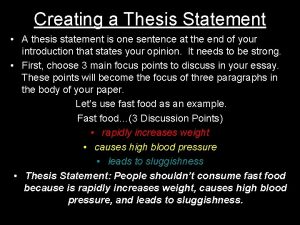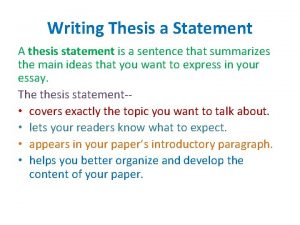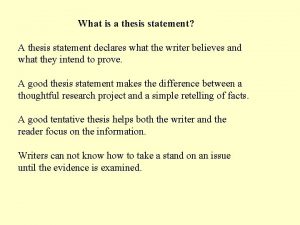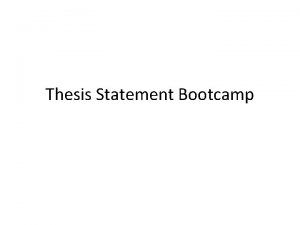Introduction to Thesis Essay Thesis statement Thesis o

























- Slides: 25

Introduction to Thesis Essay

Thesis statement (Thesis): o Your (Thesis) must take a stand on one main idea (opinion). o A specific (Thesis) should show exactly what your paper will be about, and will help you keep your paper to a manageable topic.

Thesis Statements, cont’d o Your (Thesis) will tell your audience your opinion, the reasons that support your opinion, and the order in which you will be presenting your reasons and evidence. o Your (Thesis), i. e. , argument, must have two sides. It must be debatable.

Opinion: o An opinion is a belief or judgment that falls short of absolute conviction, certainty, or positive knowledge o It is a conclusion that certain facts, ideas, etc. , are probably true or likely to prove so. o This appears in your thesis statement with reasons.

Reasons: n The reasons are the basis of an argument. n They are inferences you have made based on evidence and facts. n The reasons you include in your thesis statement will be the basis for each topic sentence in your body paragraphs.

Introductory paragraph: o This paragraph has three jobs: n to capture your audience’s interest n establish their perception of you as a writer n set out your point of view for the argument.

The Start of the Intro. Paragraph o Begin with an attention grabber/hook such as: n a quotation n a question n startling information n anecdote n irony n summary information

The Middle of the Intro. Paragraph o Follow this with either n explanation of the information just provided n background information about the subject you are going to write about.

The End of the Intro. Paragraph o Now, your reader is ready for your opinion! o Your thesis statement is usually the last sentence(s) of the introductory paragraph.

Body paragraph: o The body paragraph is typically made up of the following: n a topic sentence (ts) n Transition Lead-In (TLD) n Evidence (CD) with commentary (CM) n and a closing sentence (CS)

Topic sentence (TS): o is the first sentence of the body paragraph o organizes the entire paragraph o is one of the reasons in thesis statement o Use transitions packet

Transition Lead In (TLD) o Use a transition word to introduce your evidence (CD) o Lead in provides brief background to your evidence (CD)

Evidence; Concrete Detail (CD): o The (CD) is the support for the opinion stated in your topic sentence (TS). o Examples of evidence include: n Fact n Statistics n Quotes n Examples

Facts – (CD) o A powerful means of convincing, facts can come from n your reading n observation n personal experience. o Note: Do not confuse facts with truths. o A "truth" is an idea believed by many people, but it cannot be proven.

Statistics – (CD) o These can provide excellent support. o Be sure your statistics come from responsible sources. o Always cite your sources.

Quotes – (CD) o Quotes that support your position are invaluable n Direct from leading experts n From your reading

Examples – (CD) o Examples enhance your meaning and make your ideas concrete. o They are the proof.

Commentary (CM): o For every statement of evidence, you need to comment on, or provide an explanation of the evidence (CM). o This is an analysis of the evidence in which you explain n the value of the evidence or n the connection between the evidence provided and the topic sentence. n Think of commentary as the So What? of the quote

How do I think of commentary? Ask yourself: 1. How does this evidence prove my topic sentence or thesis? 2. What does this evidence show about my topic sentence or thesis? 3. Why is this evidence important? 4. What does this quote mean?

Closing sentence (CS): o is the last sentence in a paragraph o indicates that the paragraph is ending and sums up important points to remember o write it restating the main idea of a paragraph but using different words than the topic sentence. o You can also make a link to the next point.

What will a one-chunk paragraph look like? Sent. 1: Topic sentence 2: Evidence 1 Chunk 1 3 -4: Commentary 1 a 5 -6: Commentary 1 b 7: Concluding sentence

What will a two-chunk paragraph look like? Sent. 1: Topic sentence 2: Evidence 1 Chunk 1 3 -4: Commentary 1 a 5 -6: Commentary 1 b 7: Evidence 2 Chunk 2 8 -9: Commentary 2 a 10 -11: Commentary 2 b 12: Concluding sentence

Concluding paragraph: o This is your opportunity to wrap up your essay in a tidy package and bring it home for your reader. o It is a good idea to summarize or review what you said in your (TS) in order to suggest to your reader that you have accomplished what you set out to accomplish. o Do not, in any case, simply restate your thesis statement in your final paragraph, as that would be redundant.

What should I do in my concluding paragraph? n include a brief summary of the paper's main points. n ask a provocative question. n use a quotation. n evoke a vivid image. n call for some sort of action. n end with a warning.

What should I do in my concluding paragraph? (cont’d) n universalize (compare to other situations). n suggest results or consequences. n Finally, the conclusion is no place to bring up new ideas.
 The thesis statement
The thesis statement Introduction paragraph format
Introduction paragraph format Thesis statement for informative essay
Thesis statement for informative essay Problem solution essay thesis statement
Problem solution essay thesis statement How to write a thesis for an informative essay
How to write a thesis for an informative essay Cause effect essay thesis statement examples
Cause effect essay thesis statement examples Site:slidetodoc.com
Site:slidetodoc.com What is the genre of an essay
What is the genre of an essay What is a hook statement
What is a hook statement Expository thesis statement
Expository thesis statement Statement example
Statement example Three pronged thesis
Three pronged thesis Night essay thesis statement
Night essay thesis statement Thesis statement in essay
Thesis statement in essay Formulating a claim
Formulating a claim Introduction hook background thesis
Introduction hook background thesis Thesis statement
Thesis statement Expository vs informative
Expository vs informative Argumentative essay vs persuasive
Argumentative essay vs persuasive Expository vs argumentative essay
Expository vs argumentative essay Opinion essay vs argumentative essay
Opinion essay vs argumentative essay Dare paragraph
Dare paragraph Academic writing introduction
Academic writing introduction Essay conclusion examples
Essay conclusion examples Advantages and disadvantages essay conclusion
Advantages and disadvantages essay conclusion Thematic essay introduction example
Thematic essay introduction example


